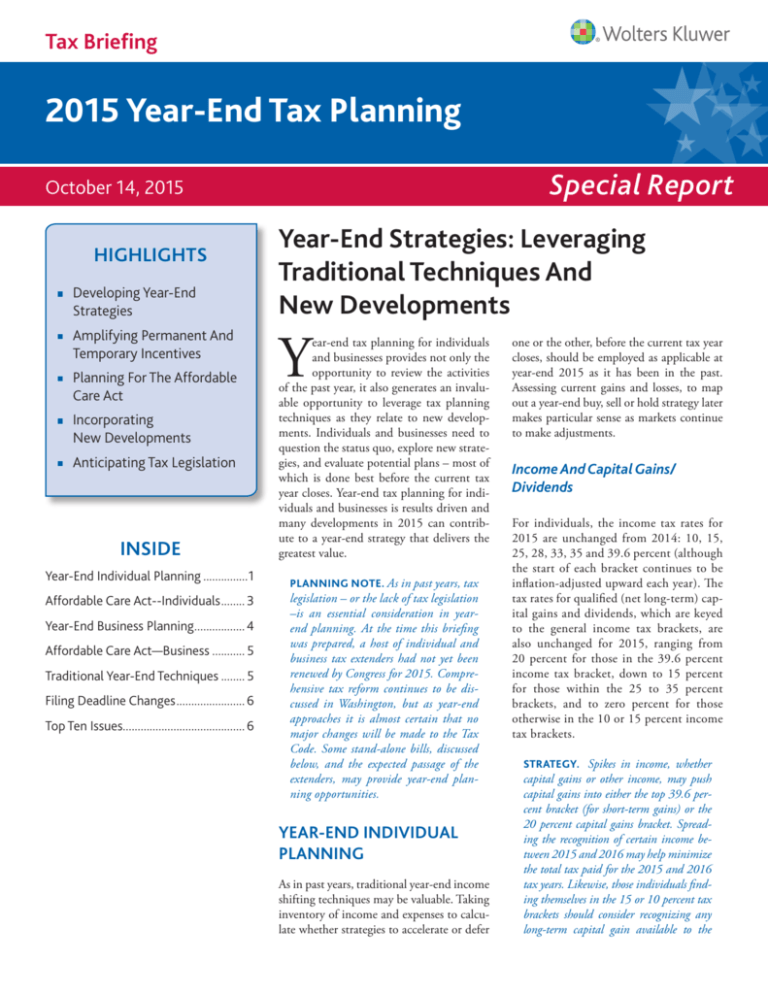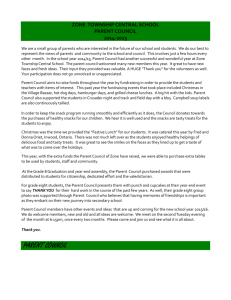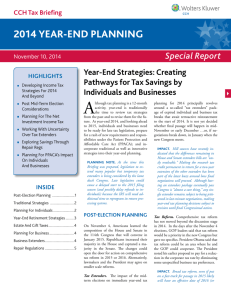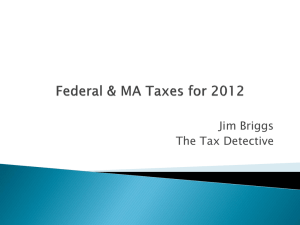
Tax Briefing
2015 Year-End Tax Planning
Special Report
October 14, 2015
HIGHLIGHTS
Developing Year-End
Strategies
Amplifying Permanent And
Temporary Incentives
Planning For The Affordable
Care Act
Incorporating
New Developments
Anticipating Tax Legislation
INSIDE
Year-End Individual Planning................1
Affordable Care Act--Individuals......... 3
Year-End Business Planning.................. 4
Affordable Care Act—Business............ 5
Traditional Year-End Techniques......... 5
Filing Deadline Changes........................ 6
Top Ten Issues......................................... 6
Year-End Strategies: Leveraging
Traditional Techniques And
New Developments
Y
ear-end tax planning for individuals
and businesses provides not only the
opportunity to review the activities
of the past year, it also generates an invaluable opportunity to leverage tax planning
techniques as they relate to new developments. Individuals and businesses need to
question the status quo, explore new strategies, and evaluate potential plans – most of
which is done best before the current tax
year closes. Year-end tax planning for individuals and businesses is results driven and
many developments in 2015 can contribute to a year-end strategy that delivers the
greatest value.
PLANNING NOTE. As in past years, tax
legislation – or the lack of tax legislation
–is an essential consideration in yearend planning. At the time this briefing
was prepared, a host of individual and
business tax extenders had not yet been
renewed by Congress for 2015. Comprehensive tax reform continues to be discussed in Washington, but as year-end
approaches it is almost certain that no
major changes will be made to the Tax
Code. Some stand-alone bills, discussed
below, and the expected passage of the
extenders, may provide year-end planning opportunities.
YEAR-END INDIVIDUAL
PLANNING
As in past years, traditional year-end income
shifting techniques may be valuable. Taking
inventory of income and expenses to calculate whether strategies to accelerate or defer
one or the other, before the current tax year
closes, should be employed as applicable at
year-end 2015 as it has been in the past.
Assessing current gains and losses, to map
out a year-end buy, sell or hold strategy later
makes particular sense as markets continue
to make adjustments.
Income And Capital Gains/
Dividends
For individuals, the income tax rates for
2015 are unchanged from 2014: 10, 15,
25, 28, 33, 35 and 39.6 percent (although
the start of each bracket continues to be
inflation-adjusted upward each year). The
tax rates for qualified (net long-term) capital gains and dividends, which are keyed
to the general income tax brackets, are
also unchanged for 2015, ranging from
20 percent for those in the 39.6 percent
income tax bracket, down to 15 percent
for those within the 25 to 35 percent
brackets, and to zero percent for those
otherwise in the 10 or 15 percent income
tax brackets.
STRATEGY. Spikes in income, whether
capital gains or other income, may push
capital gains into either the top 39.6 percent bracket (for short-term gains) or the
20 percent capital gains bracket. Spreading the recognition of certain income between 2015 and 2016 may help minimize
the total tax paid for the 2015 and 2016
tax years. Likewise, those individuals finding themselves in the 15 or 10 percent tax
brackets should consider recognizing any
long-term capital gain available to the
2015 Year-End Tax Planning
2
extent that, with other anticipated income, will not exceed the top of the 15 percent bracket ($74,900 for joint filers and
$37,450 for singles in 2015).
STRATEGY. Another strategy for some
taxpayers might be to look for a shortterm investment (bonds, etc.) payable into
next year, intended to defer the receipt of
taxable income from 2015 to 2016. The
taxpayer would not recognize income on
such investments until the maturity date
of the investment in 2016.
PLANNING NOTE. Marital status (sin-
gle, married or divorced) for the entire
tax year is determined on December 31.
Because of varying income tax brackets
depending upon filing status, a marriage
penalty or a marriage benefit may result
for any particular couple. As a general
rule, if each partner has income approximately in the same amount of the other,
they will pay more in combined tax filing a married, joint return rather than
as two single individuals. Accelerating or
postponing marriage or divorce at year
end might be considered based upon this
difference in tax brackets.
Net Investment Income Tax
Since creation of the NII tax, individuals
have learned that NII encompasses more
than capital gains and dividends. NII includes income from a business in which
the taxpayer is a passive participant. Rental
income may also be considered NII unless
earned by a real estate professional. The NII
threshold amount is equal to: $250,000 in
the case of joint returns or a surviving
spouse; $125,000 in the case of a married taxpayer filing a separate return, and
$200,000 in any other case. These threshold
amounts are not indexed for inflation.
STRATEGY. If possible, keeping modified
adjusted gross income (MAGI) below the
thresholds is an avenue to explore. Spreading
income out over a number of years or offsetting the income with above-the-line deductions are possible approaches. Again, spikes
in income should be carefully managed.
Tax Briefing
PLANNING NOTE. The NII tax is sepa-
rate from the Additional Medicare Tax.
Individuals who anticipate liability for
Additional Medicare Tax may request
that their employer(s) take out an additional amount of income tax withholding
before year end. This additional amount
will be applied against taxes shown on the
taxpayer’s individual income tax return,
including any Additional Medicare Tax
liability, and help prevent any estimated
tax shortfall.
“Year-end tax planning for
individuals and businesses
is results driven and many
developments in 2015 can
contribute to a year-end
strategy that delivers the
greatest value.”
Alternative Minimum Tax
For 2015, the AMT exemption amounts
are $53,600 for single individuals and
heads of household; $83,400 for married
couples filing a joint return and surviving
spouses; and $41,700 for married couples
filing separate returns.
STRATEGY. No single factor automati-
cally triggers AMT liability, but some
common factors are itemized deductions
for state and local income taxes; itemized
deductions for miscellaneous expenditures; itemized deductions on home equity loan interest (not including interest
on a loan to build, buy or improve a residence); and changes in income from installment sales. Investments, especially in
oil and gas, may also generate “tax preferences” that may add up to AMT liability.
Pease Limitation/Personal
Exemption Phaseout
For 2015, the Pease limitation threshold is
$309,900 for married couples and surviving
spouses; $284,050 for heads of households;
$258,250 for unmarried taxpayers; and
$154,950 for married taxpayers filing separately. The threshold adjusted gross income
amounts for the personal exemption phaseout (PEP) are the same as the threshold
amounts for the Pease limitation.
STRATEGY. Potential reduction of the
value of certain itemized deductions and
personal exemptions may be lessened by
some individuals by managing adjusted
gross income as well as affected itemized
deductions. For purposes of the limitation
on itemized deduction, a taxpayer’s total,
itemized deductions do not include deductions for medical expenses, investment
interest expenses, casualty or theft losses,
and allowable wagering losses.
Same-Sex Marriage
In Obergefell, 2015-1 ustc ¶50,357, the
U.S. Supreme Court held that the Fourteenth Amendment requires a state to license a marriage between two people of the
same sex. Further, states must recognize a
marriage between two people of the same
sex when their marriage was lawfully licensed and performed out-of-state. Obergefell was not a tax case, but the Supreme
Court’s decision will impact married samesex couples not only with return filing but
in other areas, such as employee benefits
and health care.
Tax Extenders For Individuals
Under current law, a number of popular but
temporary tax incentives are not available
for 2015 unless extended by Congress. For
individuals, these include the state and local sales tax deduction, the higher education
tuition and fees deduction, a mortgage debt
forgiveness exclusion, the teachers’ classroom expense deduction and the Code Sec.
25C residential energy property credit.
Child Tax Credit
The Trade Preferences Act of 2015 places new
limits on the child tax credit for taxpayers
who elect to exclude from gross income for
© 2015 CCH Incorporated and its affiliates. All rights reserved.
October 14, 2015
3
a tax year any amount of foreign earned income or foreign housing costs. These taxpayers will not be able to claim the refundable portion of the child tax credit for the
tax year.
Estate And Gift Taxes
The maximum federal unified estate and
gift tax rate is 40 percent with an inflation-adjusted $5 million exclusion for gifts
made and estates of decedents dying after
December 31, 2012. The annual gift tax
exclusion allows taxpayers to give up to an
inflation-adjusted $14,000 to any individual
($28,000 for married individuals who “split”
gifts), gift-tax free and without counting the
amount of the gift toward the lifetime $5
million exclusion, adjusted for inflation.
NOTE. The $14,000
($28,000) annual exclusion is a use-it
or lose-it benefit; it resets each January
1st but cannot be then retroactively taken
for the prior year. The applicable exclusion amount, as adjusted for inflation, is
$5,430,000 for gifts made and estates of
decedents dying in 2015. This exclusion
jumps to $10.86 million when spouses
combine exclusions.
PLANNING
Expatriate Gifts
The IRS issued proposed regulations under
the Heroes Earnings Assistance and Relief Tax
Act of 2008 that apply to transfers of property from individuals who have abandoned
U.S. citizenship or residency and who later
make a gift or bequest (a “covered” transfer)
to a U.S. taxpayer (either an individual or a
domestic trust).
PLANNING NOTE. An individual can-
not escape the tax by making transfers before a certain deadline. The tax itself has
applied since 2008.
Year-End Retirement Planning –
Employer Plans
One of the first steps for retirement savings
is to contribute to an employer-sponsored
elective salary deferral plan (particularly to
the extent of an employer match). These
salary deferral plans include 401(k) plans,
403(b) plans, and 457 plans (depending on
the type of employment).
STRATEGY. For 2015, the inflation-
adjusted elective salary deferral limit
for 401(k), 403(b) and 457 plans is
the lesser of $18,000 or 100 percent
of compensation. If an employer makes
contributions, the total contribution for
the 2015 year from both the employee
and the employer is capped at $53,000
(not including an additional $6,000 for
catch-up contributions). Plans rules vary
on the extent to which ability to increase
contributions at year-end.
myRAs
myRAs might be viewed as “starter IRAs” in
that they cap out at $15,000 (or 30 years,
whatever comes first). The account follows
all the other tax rules associated with regular Roth IRAs. However, myRAs have no
fees and can be opened for as little as $25
through payroll direct deposit. The account
balance will never go down in value and the
security in the account, like U.S. savings
bonds and other Treasury securities, is guaranteed. It is open to anyone who has an annual income currently of less than $129,000
a year for individuals and $191,000 for couples; but only through an employer, whose
participation is not mandatory.
AFFORDABLE CARE ACT—
INDIVIDUALS
Unless exempt, the ACA requires that all individuals carry minimum essential coverage
or make a shared responsibility payment.
Individuals with health insurance coverage
should ascertain that their coverage satisfies
the ACA’s minimum essential coverage requirements. Individuals without minimum
essential coverage may be liable for a shared
responsibility payment unless exempt. Individuals who obtain health insurance coverage through the ACA Marketplace may be
eligible for the Code Sec. 36B premium assistance tax credit.
STRATEGY. The coverage requirement
applies separately to each month. Individuals are treated as having minimum
essential coverage for a month as long as
the individual has coverage for at least
one day during that month.
A number of exemptions are available to
qualified individuals:
Religious conscience exemption
Hardship exemption
Exemption for members of federallyrecognized Native American nations
Exemption for members of a health care
sharing ministry
Exemption for incarcerated individuals
Short coverage gap exemption
Exemption for individuals not lawfully
present in the U.S.
STRATEGY. Generally, a gap in coverage
that lasts less than three months qualifies
as a short coverage gap. If an individual
has more than one short coverage gap
during a year, the short coverage gap exemption only applies to the first gap.
Individual Shared
Responsibility Payment
For 2015, the individual shared responsibility payment is the greater of two percent of
household income that is above the tax return filing threshold for the individual’s filing
status, or the individual’s flat dollar amount,
which is $325 per adult and $162.50 per
child, limited to a family maximum of $975,
but capped at the cost of the national average premium for a bronze level health plan
available through the Marketplace in 2015.
For 2015, the monthly national average premium for qualified health plans that have
a bronze level of coverage and are offered
through the Marketplace is $207 per individual and $1,035 for a shared responsibility
family with five or more members.
STRATEGY. Open enrollment for cover-
age through the Health Insurance Marketplace for 2015 has closed. However,
some qualifying life events may make an
individual eligible for non-filing season
Tax Briefing
2015 Year-End Tax Planning
4
special enrollment. An individual who
experiences a complex situation may also
qualify for special enrollment.
Health Flexible Spending
Arrangements
Contributions to health flexible spending
arrangements (health FSAs) are capped under the ACA at $2,500 (indexed for inflation). Any salary reductions in excess of the
cap subject an employee to tax on distributions from the health FSA. For 2015 and
again for 2016, the cap is $2,550.
STRATEGY. Health FSA balances are
use-it or lose-it each year, except to the
extent a plan provide a $500 carryover.
YEAR-END BUSINESS
PLANNING
As in past years, business tax planning is
uncertain because of the expiration of many
popular but temporary tax breaks that have
been part of an “extenders” package of legislation. Also added to the mix is the farreaching Affordable Care Act (ACA). Other
changes to the tax laws in 2015 made by
new regulations and other IRS guidance
should also be considered in assessing yearend strategies.
Code Sec. 179 Expensing
Code Sec 179 property includes new
or used tangible property that is depreciable under Code Sec. 1245 and that
is purchased to use in an active trade or
business. Under enhanced expensing, for
2014 and prior years, businesses could
write off (“expense”) up to $500,000 in
qualifying expenditures, and would not
reduce this amount unless expenditures
exceed $2 million. Until the enhanced
provisions are extended, these limits, respectively, are $25,000 and $200,000 for
2015 and later years.
PLANNING NOTE. Qualifying property
has included off-the-shelf computer software and certain real property.
Tax Briefing
Bonus Depreciation
S Corp Built-in Gains
Congress provided for 50-percent bonus depreciation through 2014 (through 2015 for
certain transportation and other property).
Legislation introduced in Congress in 2015
would extend bonus depreciation through
2016 or, alternatively, make bonus depreciation permanent.
If a C corporation converts to an S corporation, and the S corporation sells, during the
recognition period, assets that had built-in gain
at the conversion, a corporate level tax at the
highest marginal rate for corporations applies
to the built-in gain. This prevents a C corporation from avoiding a corporate-level tax on
appreciated property by converting to an S corporation, which sells the assets and passes the
gain through to shareholders. The recognition
period was 10 years after the conversion, reduced to seven years, and then reduced to five
years through 2014. With a shorter period, the
S corporation can sell the asset more quickly
without having to recognize the additional tax.
STRATEGY. Because
bonus depreciation, if and when extended, can
be elected on the 2015 return filed in
2016, it is not necessary for a business
to make an immediate decision on its
use, although qualifying property must
nevertheless be purchased and placed in
service in 2015. Bonus depreciation is
optional and businesses can elect not to
use it. Electing out may be appropriate
if the business wants to spread its depreciation deductions over future years
more evenly.
Research Tax Credit
The research credit is claimed for increases
in qualified research expenditures (QREs)
and for increased payments to others, such
as universities, for basic research. The research credit is a popular extender and is
expected to be renewed.
Small Business Stock
Code Sec. 1202 provides that noncorporate investors in qualified small business
stock can exclude 100 percent of any gain
realized on stock acquired after September 27, 2010, and before January 1, 2015,
provided the stock is held more than five
years. The corporation must conduct a
qualified trade or business and must not
have gross assets over $50 million. The exclusion percentage is 50 percent for qualifying stock acquired after December 31,
2014, unless Congress decides to extend
the increased exclusion.
STRATEGY. Eligible gain from disposing
of qualified stock is subject to a limit of
$10 million, or 10 times the basis of the
stock, if greater.
COMMENT. Currently, the 10-year rec-
ognition period applies for 2015.
Other Business Extenders
Other beneficial tax provisions for business
would be included in extenders legislation
for 2015 and beyond. These include:
New Markets Tax Credit;
Work Opportunity Tax Credit;
Employer wage credit for activated military reservists;
Subpart F provisions;
Enhanced deduction for contributions
of food inventory;
Empowerment zones;
Indian employment credit;
Low-income credits for subsidized new
buildings and military housing;
Treatment of regulated investment companies (RICs); and
Basis reduction of S corporation stock
after donations of property.
“Repair” Regulations
A potentially beneficial provision in final,
so-called “repair” regulations is the de minimis safe harbor. The safe harbor enables
taxpayers to routinely deduct items whose
cost is below the specified threshold.
STRATEGY. The de minimis safe harbor
is an annual election, not an accounting
© 2015 CCH Incorporated and its affiliates. All rights reserved.
October 14, 2015
5
method, so it can be made and changed
from year to year. The current threshold
is set at:
$5,000 for taxpayers with an applicable financial statement (taxpayers
with an AFS should have a written
policy in place by the beginning of the
year that specifies the amount deductible under the safe harbor).
$500 for taxpayers without an AFS.
PLANNING NOTE. Efforts being made
in Congress to raise the $500 threshold
for small businesses have met with resistance so far this year.
Routine Service Contracts
The IRS has provided a safe harbor under
which accrual-basis taxpayers may treat economic performance as occurring on a ratable basis for ratable service contracts (Rev.
Proc. 2015-39). The IRS also indicated that
additional safe harbors may be developed.
PLANNING NOTE. This new safe har-
bor should prove useful immediately in
year-end strategies taken by accrual-basis
taxpayers that are currently negotiating
contracts for regular services that extend
into 2016. Done correctly to fit under the
definition of ratable service contracts, a
full deduction in the current 2015 tax year
may be taken for certain 2015 payments,
even for services not performed until 2016.
Business Use of Vehicles
Several year-end strategies involving both
business expense deductions for vehicles
and the fringe-benefit use of vehicles by
employees involve an awareness of certain
rates and dollar caps that change annually.
Changes affecting 2015, as well as some
2016 information, include:
Standard Mileage Rate. The standard business mileage allowance rate for 2015 is 57.5
cents-per-mile (up from 56 cents-per-mile
for 2014).
Depreciation Limits. The IRS released
the inflation-adjusted limitations on
depreciation deductions for business-use
passenger automobiles, light trucks, and
vans first placed in service during calendar year 2015. The IRS also modified the
2014 first-year limitations by $8,000 to
reflect passage of the Tax Increase Prevention Act of 2014, which retroactively
extended bonus depreciation for 2014
late last year. It is uncertain whether anticipated 2015 extenders legislation will
make the same retroactive adjustment
for 2015.
PLANNING NOTE. Code Sec. 280F(a)
imposes dollar limitations on the depreciation deduction for the year the taxpayer
places the vehicle in service in its business,
and for each succeeding year.
AFFORDABLE CARE ACT—
BUSINESSES
PACE Act. In October 2015, Congress
passed the Protecting Affordable Coverage for
Employees (PACE) Act, which maintains the
current language in the ACA that defines
“small employer” as an employer with fewer
than 50 full-time employees on average during the prior calendar year for purposes of
the small group health market. The PACE
Act, however, gives states the option to apply the original definition of small employer
to employers with 51 to 100 employees for
purposes of the small group health market.
Employers should check state law.
PLANNING NOTE. Only small employ-
ers can be qualified employers who may
TRADITIONAL YEAR-END PLANNING TECHNIQUES
Traditional year-end planning techniques include:
Income Acceleration
(for postponement to 2016, delay the following actions):
Sell outstanding installment contracts
Receive bonuses before January
Sell appreciated assets
Redeem U.S. Savings Bonds
Declare special dividend
Complete Roth conversions
Accelerate debt forgiveness income
Maximize retirement distributions
Accelerate billing and collections
Avoid mandatory like-kind exchange treatment
Take corporate liquidation distributions in 2015
Deductions/Credit Acceleration
(for deferral, take contrary actions):
Bunch itemized deductions into 2015/Standard deduction into 2016
Don’t delay bill payments until 2016
Pay last state estimated tax installment in 2015
Don’t delay economic performance
Watch AGI limitations on deductions/credits
Watch net investment interest restrictions
Match passive activity income and losses
Tax Briefing
2015 Year-End Tax Planning
6
offer a cafeteria plan under Code Sec.
125 that permits their employees to enroll in a qualified health plan through
the health insurance marketplace. The
PACE Act may therefore have consequences for any large employers with between 51 and 100 employees that were
planning to take advantage of this provision after they became “small employers”
after January 1, 2016.
Health Reimbursement Arrangements.
Many small businesses have traditionally
provided a health benefit to their employees through a health reimbursement arrangement (HRA). Following passage of
the ACA, the IRS released Notice 2013-54,
which described these arrangements as employer payment plans. Therefore, they are
considered to be group health plans subject
to the ACA’s market reforms, including the
prohibition on annual limits for essential
health benefits and the requirement to provide certain preventive care without cost
sharing. Failure to comply with the ACA’s
market reforms triggers excise taxes under
Code Sec. 4980D.
PLANNING NOTE. The IRS provided
transition relief (Notice 2015-17) from
the excise taxes to qualified small employers but the relief expired after June 30,
2015. Bipartisan legislation has been introduced in the House and Senate (Small
Business Health Care Relief Act, HR
2911; Sen. 1697) to provide permanent
relief for small employers.
Small Business Health Care Tax Credit.
Small employers with no more than 25 fulltime equivalent employees may qualify for
a special tax credit to help offset the cost of
health insurance for their employees. The
employer must pay average annual wages
of no more than $50,000 per employee (indexed for inflation) and maintain a qualifying health care insurance arrangement.
STRATEGY. The small employer tax cred-
it may be carried back or forward. Small
businesses that do not owe tax may take
Tax Briefing
advantage of the credit in a prior year or
a future year, if eligible.
FILING DEADLINE CHANGES
Due to changes in the tax laws and other
events, some deadlines will be changing
starting in 2016. As a result, planning at
year-end 2015 might start factoring in some
of these deadlines when setting out schedules and strategies at the start of 2016. Notably, under the Surface Transportation Act
of 2015 partnerships will be subject to an
earlier March 15 deadline and C corporations generally will move to an April 15th
deadline starting for 2016 tax year returns.
Extensions-to-file are also adjusted.
Filing Deadline
A Washington, D.C. holiday, Emancipation Day, will shift the filing and payment
deadline for 2015 individual returns from
April 15, 2016 to April 18, 2016. Taxpayers in two states (Maine and Massachusetts)
will have one additional day to file because
of Patriots Day, which will be observed on
April 18, 2016 in those states.
Delay of Estate Tax
Uniform Basis Reporting
The IRS delayed new uniform basis reporting requirements for estate tax property until
February 29, 2016. The delay was provided
to give the IRS time to issue guidance to executors, beneficiaries, and others on how to
comply with the new reporting requirements.
FBARs
The due date going forward for filers of
FBAR (FinCEN Report 114) will shift from
June 30 to April 15, applicable for FBARs
for tax years beginning after December
31, 2015. The Surface Transportation Act
also provides that any penalty for failure to
timely request or file an extension may be
waived for taxpayers required to file Report
114 for the first time. The IRS is also given
authority to modify regulations to provide
for a maximum extension of six months
ending on October 15.
PLANNING NOTE. Treasury’s Financial
Crimes Enforcement Network (FinCEN)
again postponed the Report of Foreign Bank
and Financial Accounts (FBAR) (FinCEN
Form 1114) filing deadline for certain individuals with signature authority over but
no financial interest in one or more foreign
financial accounts to June 30, 2016.
PLANNING NOTE: 2015 has been a
successful year for Treasury Department
efforts to gain international cooperation
against unreported offshore accounts. The
Foreign Account Tax Compliance Act of
2010 (FATCA), enables the IRS, under
the threat of 30 percent withholding, the
obtain information from foreign financial
institutions on foreign accounts that have
U.S. owners. On September 30, 2015,
the IRS announced a milestone under
FATCA, signaling an initial exchange of
financial account information under the
authority of intergovernmental agreements
(IGAs) negotiated by Treasury with foreign jurisdictions. U.S. taxpayers holding
foreign assets, whether individuals or businesses, need to reexamine their compliance
as year-end approaches, particularly in
light of stepped-up IRS enforcement.
TOP TEN ISSUES FOR
THE REST OF 2015
1. Timing and extent of an
extenders package
2. Affordable Care Act
3. International tax compliance
4. Repair regulations
5. IRS operations
6. Net investment income (NII) tax
7. Retirement planning
8. Identity theft
9. Preparer oversight
10. Tax reform—the long view
© 2015 CCH Incorporated and its affiliates. All rights reserved.
Resources you can count on for
the latest legislative coverage
CCH® Federal Tax Perspectives:
2015 Year-End Planning eBook
Tax Practitioner’s Guide
to Identity Theft, 2015
Learn how these developments impact
this year’s year-end tax strategies,
along with authoritative comments
and planning from Wolters Kluwer’s
industry-leading editorial experts.
Tax-related identity theft crimes
have risen dramatically in recent
years, with millions of victims affected
annually. This guide explores federal
and state statutes that criminalize
identity theft.
ll
Learn what transitional rules have developed to comply with the mandates
under the Affordable Care Act, both for individuals and businesses
ll
Provides 25 “best practices” clients can employ to decrease the risk of both
tax-related and non-tax related identity theft
ll
Recognize how certain year-end strategies have changed as the result
of IRS guidance and enforcement efforts over the past year
ll
Contains identity theft resources that state governments and their tax
authorities make available to residents
ll
Review traditional year-end techniques in light of current trends
ll
Includes an Appendix with Checklists for resolving tax-related identity theft
ll
Double-check strategies with checklists on life-cycle events and deferral/
acceleration pointers.
Just $24.95
Just $49.95
BUY NOW
CCH® Federal Tax Perspectives:
ACA Large Employer Compliance
and Reporting, 2015
CCH® Federal Tax Perspectives:
ACA Small Business Tax
and Compliance
Coverage of Employer Shared
Responsibility payments under
Code Sec. 4980H(a) and (b),
determination of Applicable Large
Employer status, health insurance
requirements and related reporting.
This title fills the gap between
individuals and large employers
covering the SHOP (Small Business
Health Options) Marketplace, the
Small Employer credit as well as selfemployed and self-insured coverage.
ll
Health coverage provider reporting on Forms 1094-B and 1095-B
ll
Compliance with ACA market reforms
ll
Applicable large employer reporting on Forms 1094-C and 1095-C
ll
ll
Includes Look-Back period examples with graphic timelines, annotated
forms, filled in form examples, charts, FAQs, and reporting checklists
The effects of the ACA on employer self-insured plans including PCORI
fees and coverage provider reporting
ll
Claiming the Small Employer Tax Credit with filled-in forms example
Just $49.95
BUY NOW
Attend CCH® Seminars and Earn CPE!
Authoritative seminars in the convenience of your office on a variety of tax and
accounting topics, including the latest developments and tax legislation changes.
Visit CCHGroup.com/Seminars for a calendar of upcoming CCH Seminars.
2014-0216-16
BUY NOW
Visit CCHGroup.com/Legislation
for the latest updates as they happen.
Just $19.95
BUY NOW




